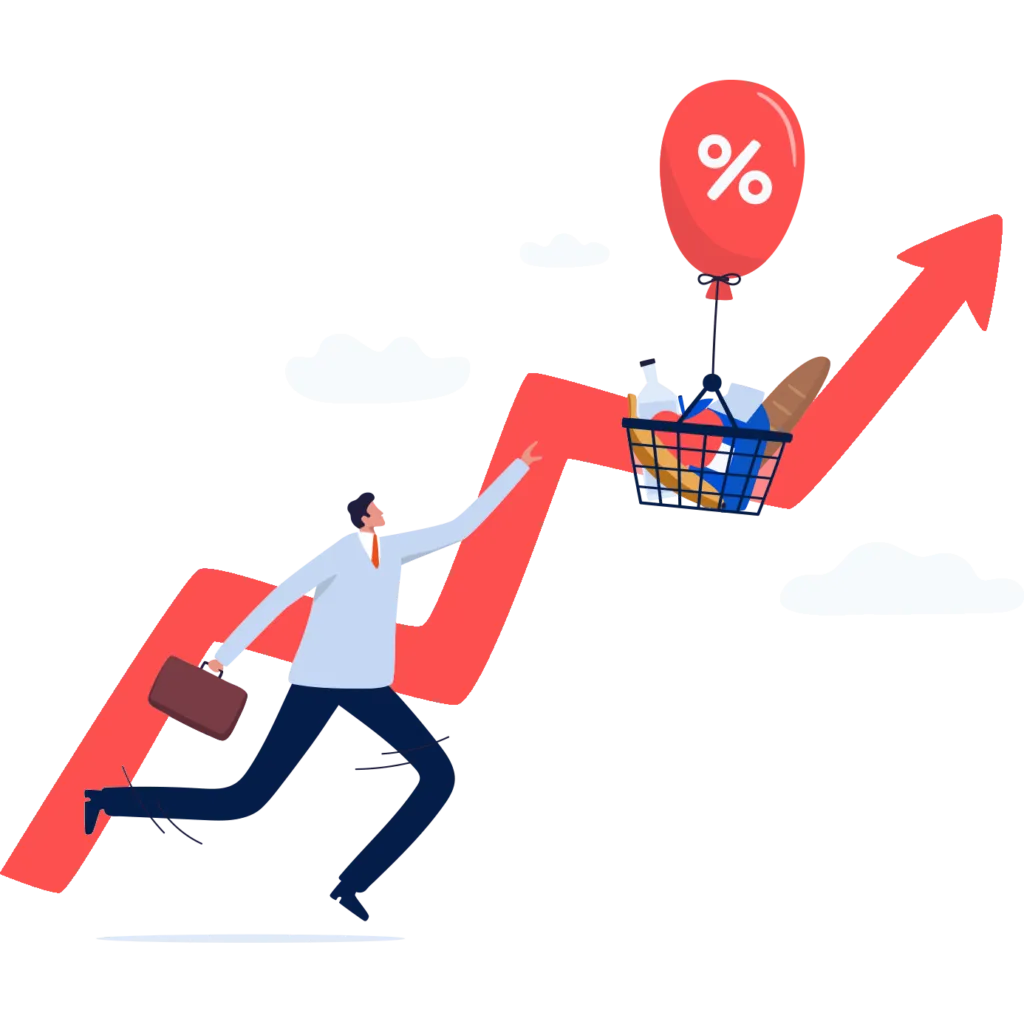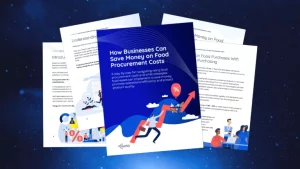

[generate_toc]
Have you ever felt there’s untapped potential in procurement to propel the business to new heights? What if procurement wasn’t just about cutting costs and securing deals?
What if it could be the driving force behind the company’s growth – an epicenter of value creation?
Makes sense, right? It also probably sounds a little overwhelming. But don’t worry, we’ve got you covered. This playbook provides a guide to moving beyond old-school perceptions of procurement and becoming one of your organization’s most important sources of value.
Ready to boost business growth? Let’s do it.
Anyone who tells you that managing this category is easy has probably never tried to do so. Here are just some of the challenges typically faced in food procurement:
Navigating these issues requires a strategic blend of culinary prowess and financial acumen. Successful businesses understand that tackling these challenges head-on is not just about saving money; it’s about creating a resilient, adaptable food procurement category that can weather any storm.
Making a meal at home involves several steps. First, you need to plan the menu and pick the ingredients. Then you’ll need to compare which vendor has the best price, decide which supplier you’ll buy them from, pay for the goods, arrange delivery, then assess the quality of the products received. And then, figure out how you can make a better meal next time.
Food procurement in business follows the same steps as you would at home, except for on a much larger scale.

In food procurement, this means menu and ingredient planning. Food procurement professionals don’t necessarily need to be “foodies” – this stage is often carried out by a Group Chef or equivalent role.

Who produces the goods you need? Are they reliable in terms of quality and delivery? Is their pricing competitive?

Negotiate the best-possible price and find out what the supplier needs to meet your requirements. Building a strong relationship will make it easier to win a great deal and manage changes in demand or unexpected hiccups.

It’s not just about receiving the goods on time in food procurement. With expiry dates and refrigeration to manage, the food supply chain presents a whole new level of complexity.

Drive continuous improvement by assessing quality, service, and look for opportunities for innovation and cost reduction.
With inflationary pressure, constant disruption and other factors driving up food costs, what can we do to bring them back down?
Below, we explore menu optimization, inventory management, supplier management, supply chain optimization, and – your secret weapon – group purchasing.

Menu optimization is a tried-and-true recipe for success. It’s not just about what’s on the plate; it’s about orchestrating a menu that balances flavor, cost, and customer satisfaction.
“Menu engineering” is the art of strategically crafting a menu to maximize profitability. It involves categorizing dishes based on their popularity and profitability, ensuring that the star players shine while steering customers toward high-margin items. By identifying winners and optimizing placement, businesses can elevate their bottom line without sacrificing customer enjoyment.
Here are some menu engineering tips:
Reduce food waste
This isn’t just a sustainability move; it’s a financial win. Smart portioning, creative repurposing of ingredients, and offering customizable options can minimize waste. It’s a juggling act between meeting customer expectations and managing ingredient usage efficiently.
Embrace a seasonal menu
Embracing the seasons isn’t just for Instagram-worthy aesthetics; it’s a cost-saving strategy. Seasonal ingredients are often more abundant and cost-effective. A seasonal menu allows businesses to capitalize on freshness while adjusting prices to reflect market conditions, providing a win-win for both the kitchen and the consumer.
Incorporate more affordable ingredients
Flexibility in ingredient choices doesn’t mean compromising on taste. Exploring cost-effective alternatives, sourcing locally, and negotiating bulk deals with suppliers can significantly trim expenses. Moreover, customer education on the value of these substitutions fosters a transparent relationship, turning cost-cutting measures into a unique selling point.
If you have a chef who demands only the very best (and most expensive ingredients), procurement’s job is to push back and help them consider other options.
At its core, inventory management involves systematically tracking and controlling a business’s stock of ingredients. This process ensures a balance between having enough to meet demand and avoiding excess that can lead to waste.
Tracking inventory levels isn’t a mundane task – it’s a financial compass for a business. It prevents overstocking, which ties up capital and risks perishable items going to waste. Simultaneously, it ensures that the organization is well-equipped, avoiding scenarios where popular items run out unexpectedly.
Inventory management is a powerful weapon against food waste.
By establishing a clear system for tracking expiration dates, rotating stock, and optimizing portioning, businesses can boost sustainability and safeguard the bottom line. Inventory data isn’t just numbers on a spreadsheet; it’s a goldmine of insights for informed decision-making. Analyzing consumption patterns, identifying fast-moving items, and understanding seasonal fluctuations empower businesses to make strategic purchasing decisions.
Negotiating with suppliers, taking advantage of bulk discounts, and optimizing order quantities become precision moves when you’re armed with trusted data.
Build supplier relationships by prioritizing clear communication, reliability, and mutual trust. Consistent business, prompt payments, and a collaborative approach will help move partnerships from transactional to strategic. Establishing robust relationships with suppliers isn’t just a formality; it’s the backbone of a resilient food procurement strategy. These partnerships foster trust, reliability, and open communication, ensuring a seamless food supply chain.
From negotiating favorable terms to adapting to market changes, effective supplier management transforms transactions into long-lasting culinary alliances. Conduct regular food tastings, gather constant feedback and establish a set of KPIs to help ensuring quality and consistency of products from suppliers. In the food game, negotiating prices with suppliers is a skill worth having. Know the market and your budget, and consider buying in bulk for better deals (more on that below).
Payment flexibility can be a bargaining tool – consider asking for a longer payback period or get an early payment discount. Long-term relationships can help; suppliers might cut a deal for steady business. Timing matters too – plan purchases when prices are low.
Lastly, talk openly about prices, budgets, and find solutions that work for both sides. It’s not just about getting a lower price; it’s about finding a fair deal that keeps both the supplier and the business happy.
Supply chain management is the strategic coordination of every link in the food procurement process. From paddock to plate, it’s about streamlining operations, minimizing waste, and ensuring a seamless flow from the supplier to you. Get it right, and you’re have improved inventory control, timelier deliveries, reduced operational costs and enhanced business resilience.
Tips for reducing costs include:
Optimizing delivery schedules
By synchronizing deliveries with operational demand, businesses minimize storage costs and reduce the risk of overstocking. Efficient scheduling ensures that ingredients arrive just in time for culinary creations, minimizing holding costs and maximizing freshness.
Reduce transportation costs through consolidation
By bundling shipments and leveraging economies of scale, businesses can negotiate better rates with carriers. This not only reduces per-unit transportation costs but also minimizes the environmental footprint.
We said we’d save the best till last, so here it is! Businesses can secure massively lower food prices by tapping into the power of a group purchasing organization (GPO) like Una.
Una focuses on leveraging the combined purchasing needs of our members to secure deep discounts on food items from the nation’s leading food distributors. Any private sector business with spend in this category can take advantage of unprecedented contract value and savings on food purchases via Una’s foodservice GPO model.
We take the guesswork out of pricing models, logistics, and distribution, and gives our members the peace of mind knowing their food programs are operating as efficiently as possible.
Our members save an average of 15% – 20% on food costs and have access to additional perks like rebate incentives, price protection guarantees, and powerful reporting capabilities.
We have long-established relationships and over 300 pre-negotiated agreements with top suppliers, provide businesses with reduced costs, and help slash the administrative burden associated with RFX processes and contract negotiations.

The Una team is passionate about providing a food cost reduction program that saves our members money while simultaneously adding value and streamlining the way they do business.
Here are some benefits of working with a foodservice GPO:
YPurchasing is a group purchasing organization dedicated to providing savings programs to YMCAs across the United States. The organization works with suppliers and vendors to secure the best possible pricing, quality products, and services to directly impact each YMCA’s mission.
With over 80 contracts and vendors in place, YPurchasing was looking to add additional cost savings opportunities in the food category and partnered with Una to make it happen.
Read on to learn more about their success with Una’s food cost reduction programs.

In this playbook, we’ve navigated the challenges of food procurement, from inflationary pressure to supplier reliability. Menu optimization, efficient inventory management, and strategic supplier relationships emerged as key players.
Supply chain optimization, technology, and the superhero of savings – group purchasing – also took the stage.
Let’s cut costs and streamline your food procurement journey. With 300+ pre-negotiated agreements in the food distribution space, Una has the recipe to make it happen.
Contact the Una Team to get started and download the full playbook here👇
